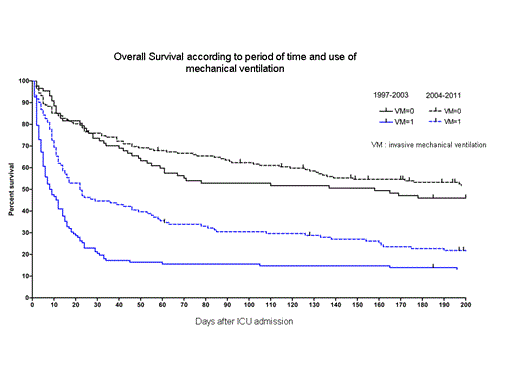Allogeneic hematopoietic stem cell transplantation (HSCT) is increasingly used for the treatment of various hematological conditions with poor outcome. However, despite its effectiveness opportunistic infection, graft versus host disease (GVHD), drug toxicity and relapse frequently lead to life threatening complications and 15-20% of HSCT recipients ultimately require life sustaining therapies. Nowadays, a trend toward the use of less toxic conditioning regiments, different graft sources and better management of GVHD is observed. Also recent finding emphasize advances in the ICU management and triage policies of hematological patients. However, it is not known whether these changes altered the typology and outcomes of HSCT recipient admitted to ICU. We then performed a multicenter study to assess the impact of these changes.
All adults admitted in 3 ICU in Paris France from 1997 to 2011 were included if they previously received an HSCT. Data from medical charts were retrospectively retrieved and analyzed after the patients gave written informed consent. 497 patients were included, among whom 209 were admitted in the 1997-2003 period (this cohort was already published)1 and 288 in the 2004-2011 period. This corresponded to 2286 HSCT procedures over the same centers and period of time. Patients, HSCT characteristics and outcomes of the 2 cohorts were compared and prognostic factors analysis was performed in the recent period cohort.
Over the time, HSCT recipients were more likely to be older (48 vs. 41 years old p<0.001), transplanted with a reduced intensity conditioning (46% vs. 10% p<0.001), peripheral blood mobilized stem cell (67% vs. 28% p<0.001) and an unrelated donor (37% vs. 29% p<0.001). ICU admission rate was 22% and remain stable over time (p=0,17). ICU admission triage was more frequent with less patients admitted with graft versus host disease (GVHD) stade over 2 (27% vs. 52% p<0,0001) and absence of hematological remission (33% vs. 56% p<0,0001). Admission occurred with a median time of 72 vs. 75 days after HSCT procedure with no difference over time p=0.68. Finally, organ dysfunction severity scores were not different between the 2 cohorts. We observed a significant survival improvement over the time as ICU, Day 90 and 1 year survival in the 2004-2011 cohort was respectively 71%, 49% and 37% vs. 48%, 31% and 21% previously. This was mainly due to improvements in the subset of patients requiring mechanical ventilation as shown in Figure 1. Also non-invasive ventilation use was similar between the 2 cohorts but more frequently successful (not followed by invasive ventilation) in the 2004-2011 cohort (51% vs. 33%). In the recent cohort, univariate analysis of Day 90 mortality showed that no demographic or HSCT parameter was associated with mortality. Only graft versus host disease (p<0.001) and life sustaining therapies use (p<0.001) CMV reactivation (p<0.001) and invasive fungal infection (p=0.03) were found as mortality determinant. We then tested whether the strength of prognostic factors were changing with time using Gail and Simon interaction test and revealed that renal and respiratory failure and CMV reactivation were all three most strongly associated with mortality in the recent cohort. Logistic regression analysis revealed that, in the 2004-2011 cohort, the presence of acute GVHD stade > 2, mechanical ventilation and renal replacement therapy were independently associated with day 90 mortality.
Despite improvement of ICU care in HSCT patients with no GVHD, this study show that life-sustaining therapy still remains mostly unsuccessful when used in patients with GVHD and deep immunosuppression. These data argue for a more rational policy of ICU admission triage in HSCT recipient
1Pene, Aubron, Azoulay et al. J. Clin. Oncol. February 1, 2006; 24(4): 643 - 649.
No relevant conflicts of interest to declare.


This feature is available to Subscribers Only
Sign In or Create an Account Close Modal